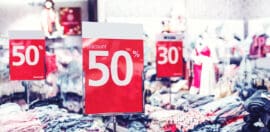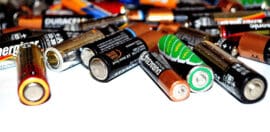How Officeworks is integrating sustainability into all its decision-making

Ryan Swenson is the head of ESG and corporate affairs for Officeworks.
5 April 2022 at 8:28 am
We caught up with Ryan Swenson, head of ESG and corporate affairs for Officeworks, to talk about ESG strategy and the business plan behind protecting both people and planet.
Officeworks has come a long way since establishing its long-term ESG strategy in 2015. Now, seven years later, the business is looking towards 2025 and working hard to integrate sustainability into all of its decision-making.
We caught up with Ryan Swenson, head of ESG and corporate affairs for Officeworks, to talk about how the business plans to bring sustainability to the forefront as well as why it feels a responsibility to show the industry the positive side of doing sustainable business.
Tell me a bit about how Officeworks defines the term sustainability from a business perspective…
In the simplest form, it’s really about how we make a positive impact on people and planet while aligning ourselves with the issues that are most important to our stakeholders. We then anchor all that to a long-term ESG strategy, and focus on the areas where we can really make a difference. Our aim is to demonstrate to our industry that operating in a sustainable way can also make businesses perform better. We want to inspire greater action towards the SDGs from the private sector, and encourage others to do the same.
And when you say “issues that are most important to stakeholders” how do you find out what those issues are?
Every two years we undertake materiality assessments, which is essentially when we interview our key internal and external stakeholders about what matters to them. We started doing this back in 2014, the results of which have really informed our goal-setting over the past few years. Having gone through the assessments a number of times now, it’s been really interesting to see how our stakeholder expectations have shifted.
And how have they shifted?
Pre-2015, before we had a long-term strategy, we had great intent and everyone knew that being more sustainable was the right thing to do but our approach was really just a lot of tactical initiatives. Once we listened to our stakeholders, and understood what the priorities were, we were able to set long-term targets.
Those targets were very specific, and centred around supporting our team members and communities, reducing our environmental impact and sourcing products responsibly and sustainably. We made significant progress across the eight targets, including improving team member safety and sourcing paper and wood sustainably. As we started to look towards 2025 it was clear that ESG went beyond addressing specific issues and was more about capability. Over the last two years our stakeholders have said that to achieve our people and planet positive ambitions we need to make sure we’re integrating sustainability into all of our decision-making.
We have also had to recognise that we’re a leader in many aspects, and with that comes responsibility to educate others, to advocate and communicate more. We also want to elevate diversity and not just internally but integrate it into our community activities and help educate the community. And we also want to expand our approach to waste and emissions, so really influencing change right through the supply chain.
We’ve addressed how we approach things internally, and now stakeholders are saying: “okay, you’ve now got a role to really influence change beyond what you directly control and the industry more broadly”.
And so from an advocating perspective, do you advise other businesses on sustainable thinking?
If I look at what we’re doing with our suppliers, and our partners, that’s definitely about showing other businesses what’s possible. We have our own brand products and we lead by example and set high standards with these products. Over the past two years we’ve also played a key role in communicating with, and educating, our customers on sustainability. For example, we’ve just launched a pen recycling programme and our community team is giving boxes out to schools and childcare centres so they can collect pens and markers to be recycled. And then with our peers, in November last year, we came together with IKEA, Target and Kmart to launch the Race to Zero retail campaign as part of the UN backed programmes globally. In February, we announced our investment in The Worlds Biggest Garage Sale, to help scale their circular economy precincts across Australia and support a more sustainable retail industry in the process.
So for us, it’s about advocacy that’s supported with action.
What role do you think brands play in bringing positive change?
I think it’s a really important role, and it starts with your team. When we educate people at work about, for example, recycling then those practices go back home with them. From a customer’s perspective, research shows that the vast majority of Australians want to make more sustainable choices and the role of brands is how to alleviate the barriers to sustainability? As a brand you need to make sustainable products and services easy to find in store, affordable and of good quality.
What’s been the trickiest aspect of tackling sustainability as such a large business?
I think it comes down to when we try to influence aspects of the business that we don’t directly control, for example other brands and their supply chains.
How do you work around that?
Good partnerships are crucial, and also setting long-term direction. So when we had the goal of getting all 8,000 of our paper products FSC certified, we gave our suppliers five years to build their capability and make the transition.
How much importance does the business place on transparency ?
It’s fundamental to much of what we’re trying to do particularly on the material sourcing side of things, but also the claims we make on our products. As we bring more sustainable products to the market – there’s now about 2,000 greener choice products – we do our due diligence and ensure that any claims we make are supported with really clean documentation and evidence. It’s why we work with the likes of GECA to apply a claims authentication label on our educational products.
We think that the GECA label is a great solution that could be adopted across retail. So, in the absence of trusted labels like FSC, when you’ve got materials such as recycled plastic content, this independent label does the work in validating our sustainability work to the consumer. It helps to build trust.
We’ve also got a responsibility to make sure all the products we sell, which is 40,000 of them, are all sourced ethically.
How do you do that with 40,000 products?
It starts with transparency around where the products are manufactured. We have a mature ethical sourcing programme, which was started back in 2013. We utilise Sedex as a platform for the data and third-party ethical sourcing audits play a key role as well. We’re now going beyond the audits though and working directly with the factories and their workers.
Over the past 18 months we’ve facilitated worker surveys that encourage our manufacturers to interview their workforce to understand the issues that are important to them. And then implement the required improvements. What that showed was when factory management took corrective actions and made improvements, productivity went up. It then gives them a quantitative reason why the business should invest in looking after their workforce. I think that kind of goes to the heart of what we’re trying to achieve with sustainability – the more we can educate on the value of sustainability in business the better it is for everyone.
So getting down into the weeds of Officeworks’ impact, how does the business approach its environmental impact?
From an environmental perspective, we have nine commitments that include taking meaningful climate action, contributing to a more circular economy, and helping customers shop more sustainably.
Our Restoring Australia environmental initiative is one of our key programs. It addresses one of our biggest sustainability issues, relating to paper, and provides an easy way for customers to make a difference.
The concept is that Officeworks plants two trees for every one used, calculated on the weight of paper-based products customers buy. We work with Greening Australia, and so plant across various sites across the country to restore the Australian landscape. In September last year we hit the milestone of planting one million trees, which is halfway towards our goal of two million by 2025.
What’s really incredible about the project is the diverse benefits of tree planting and land restoration. We’ve got projects in Queensland where we’re planting trees to improve water quality in coastal wetlands and reduce soil runoff, which in turn has played a role in protecting the Great Barrier Reef. We’ve got other sites in Western Australia where we’re helping traditional owners of the land return it to its original habitat. It’s a pretty incredible programme.
How much focus does the business put on culture when it thinks about sustainability?
I think it’s one of the most important things. If you get the culture right then everything else will flow much easier. As the business has matured and our sustainability strategy has evolved we’ve invested a great deal of work in bringing the team along with us on the journey.
What kind of things have you done to involve them?
As part of our journey to become a zero waste business we sent 30 different stores on a full-day waste and recycling workshop. A large three-metre bin came out and was tipped upside down and then teams had to sort the rubbish into what was recyclable and what was landfill. Through that exercise alone, they learned that the amount of waste in the bin could’ve been reduced by 80 per cent simply through knowing what was able to be recycled. And that in itself has now led to some incredible initiatives at stores and helped us recycle 91 per cent of all of our waste.
Our team members are coming up with great ideas. We’ve got an arts and crafts repurpose station where certain off-cuts are put into special in-store bins and teachers, or kindergarteners, can come in and collect those products for projects. Our latest investment in World’s Biggest Garage Sale started with our supply chain team in Queensland looking at partnerships to deal with waste.
Once you’ve embedded sustainability into your culture you can empower your team. And as we’ve evolved, we’ve then taken them on a journey around climate action with formal training and getting as many people out on the land as part of our Restoring Australia project.
What’s the focus for the next 12 to 18 months?
We’ll continue to make progress on our People and Planet Positive 2025 commitments, and in addressing the issues our stakeholders have raised, as mentioned earlier.
From an environmental perspective, working towards our net zero goal and supporting the transition to a circular economy remains a priority. We’ve done a lot of work around moving to 100 per cent renewable energy and now we’re just in the process of working on our scope three emissions, and we’ll share some more updates on that later this year. We’ve also got a great opportunity with our recent investment in World’s Biggest Garage Sale, and want to take that concept all across Australia.








So encouraging to see larger business make steps forward. It has to start somewhere.